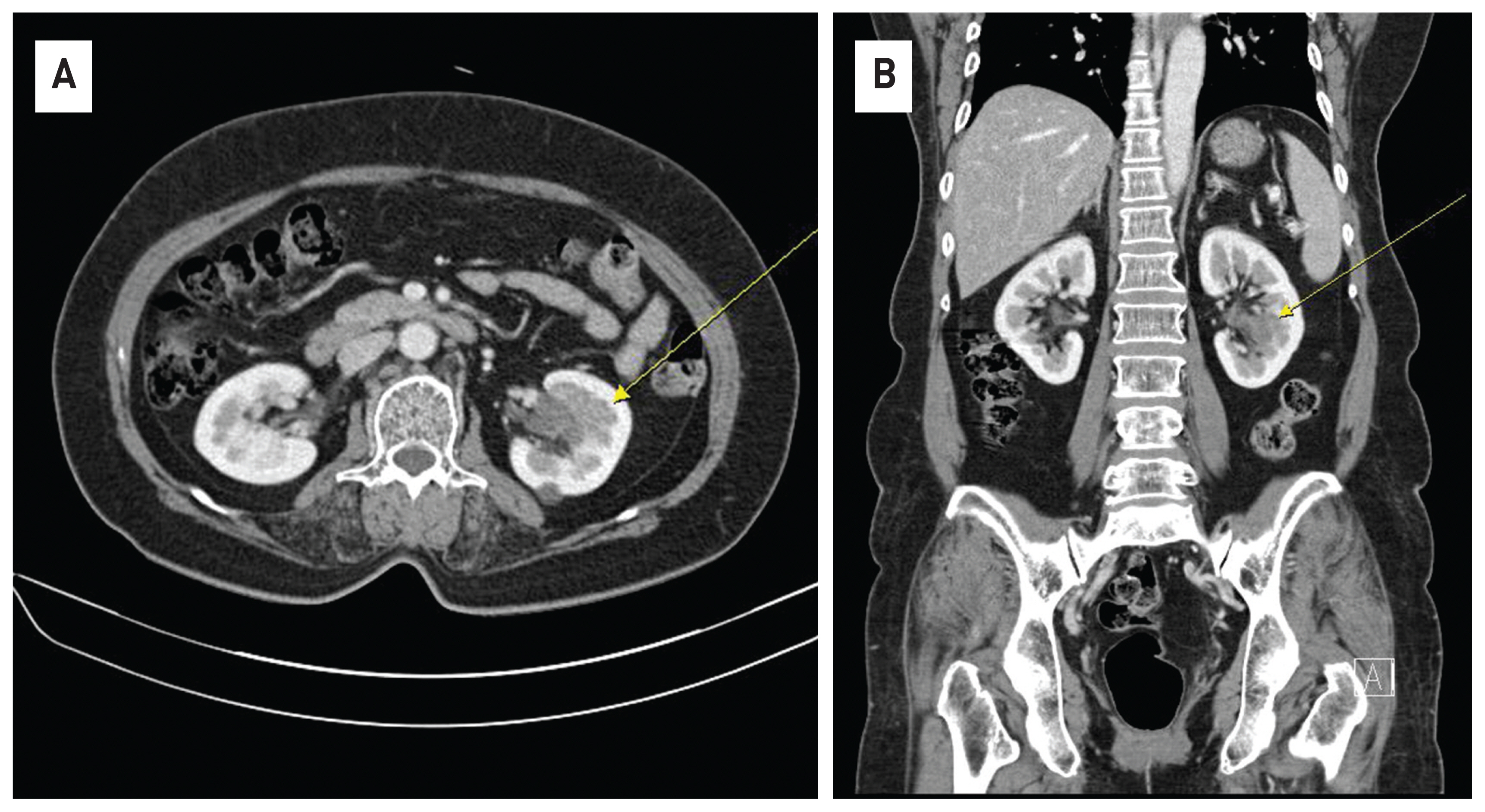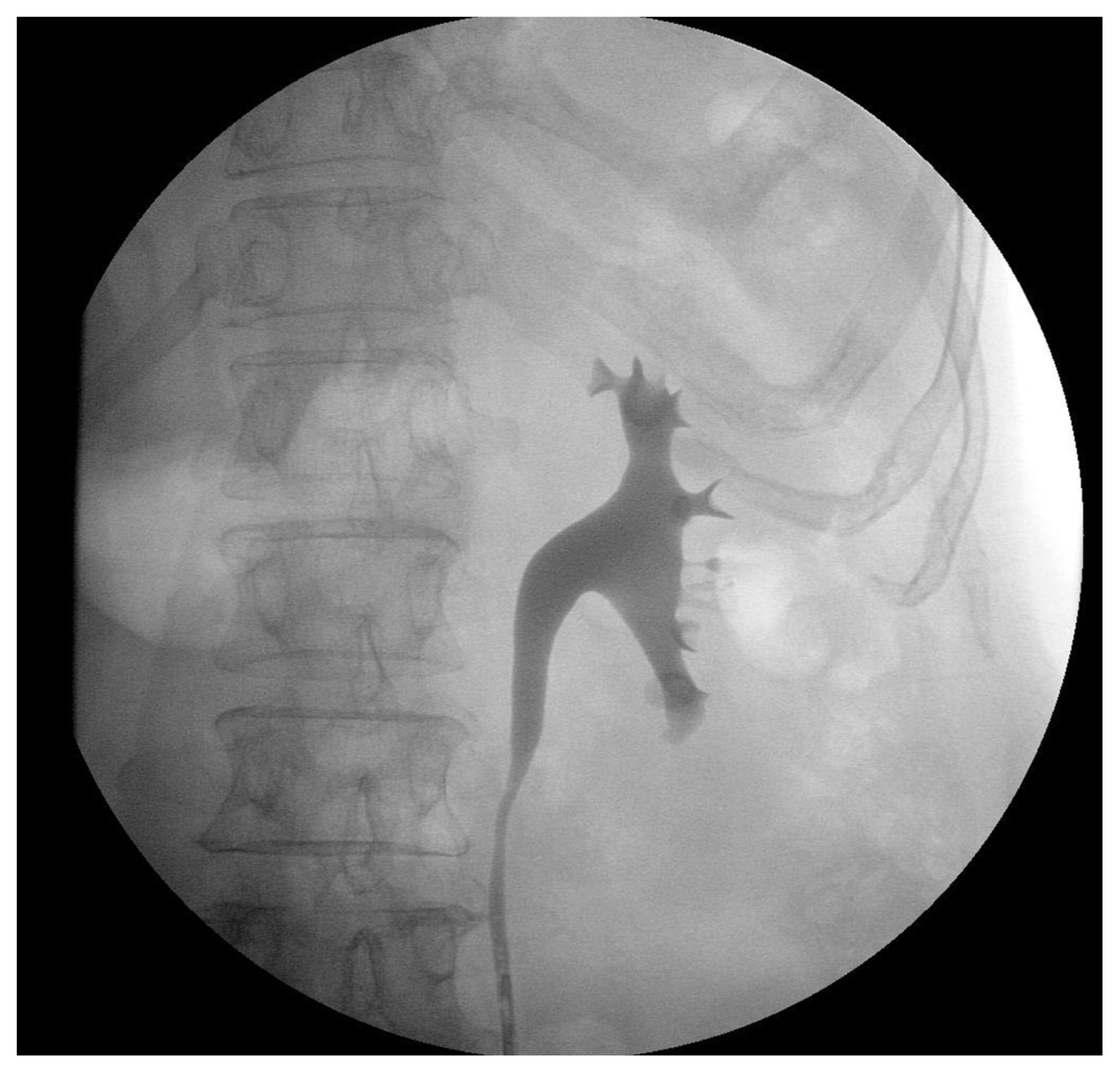Hemangioma in Renal Pelvis
Article information
Abstract
Hemangioma in the renal pelvis is a very rare benign tumor that may be mistaken for renal cell carcinoma. We present, herein, a case of a 59-year-old woman with a renal mass that was diagnosed as a cavernous hemangioma in the renal pelvis. The patient underwent intravenous pyelography, urine cytology, retrograde pyelography, kidney dynamic computed tomography (CT), and surgical excision.
A cavernous hemangioma is a benign tumor that occurs in the renal pelvis very rarely.1 Most of them are 1 to 2 cm in size and have a gross hematuria with or without pain, which are known to be very difficult to diagnose before surgery.1 The authors accidentally discovered the 3 × 3 cm cavernous hemangioma in the renal pelvis of a 59- year-old female patient who was hospitalized with a painless gross hematuria as a main complaint. Therefore, we’d like to report this case along with a literature review.
CASE
A 59-year-old female patient with a painless gross hematuria that started 5 days before being admitted to a private hospital was taken from the hospital for a computed tomography . The patient was then transferred to this hospital for precise examination and treatment. According to her medical history, she had been taking medication for hypertension from another hospital for 10 years and there was nothing unusual in her family history. Based on the examination findings, she was alert with a height of 155 cm, weight of 65 Kg, blood pressure of 130/80 mmHg and pulse rate of 76/min. Her breathing rate was 20/min and her temperature was 37.0 C. There were no abnormal findings in heart sound and respiratory sound, abdominal auscultation, palpation and side abdominal percussion. In the laboratory tests, there were no unusual findings in a complete blood test and blood chemistry tests. In the urinalysis many/high-power fields (HPF) and WBC 0–1/HPF were observed. From the intravenous pyelography (IVP) performed, a filling defect in the middle calyx of the left kidney was suspected (Fig. 1), and blood leakage in the left ureteral opening was observed from the cystoscope. The result of a urine cytology test was negative. A retrograde pyelography (RGP) confirmed the filling defect in the middle calyx of the left kidney (Fig. 2). Kidney dynamic computed tomography (CT) was carried out and a poorly enhanced 3.5 × 4.5 cm diameter round local mass was observed in the middle calyx of the left kidney (Fig. 3). Therefore, the authors performed a left nephrectomy as indicated for the treatment of kidney cancer. The post-op progress was good, and it was diagnosed as hemangioma in the left renal pelvis from the pathological biopsy (Fig. 4).

(A) Axial kidney dynamic computed tomography (CT) images show a poorly enhanced mass-like lesion in the upper calyx of the left kidney (arrow). (B) Coronal kidney dynamic CT images show a poorly enhanced masslike lesion in the upper calyx of the left kidney (arrow).
DISCUSSION
A hemangioma is a vasculogenic tumor which can be divided into benign hemangioendothelioma, capillary hemangioma, cavernous hemangioma, venous hemangioma, and racemose hemangioma.1 A cavernous hemangioma is mostly found in the skin or the surface of a mucous membrane, and occasionally it is found in the liver, spleen, pancreas or kidney.1,2 It usually affects people between the ages of 30 to 40 years old. Both the ratio between men and women and the left and right ratio are the same. Although most cavernous hemangioma occur unilaterally, 12% occur in multiple.3 In general, cavernous hemangioma occurs alone in the urinary tract, but rarely it can be accompanied by multiple sclerosis, Sturge-Weber syndrome, or Klippel Trenaunay-Weber syndrome.3,4 The size is usually reported as about 1 to 2 cm and it may have a similar diameter with the kidney size.3,4
Clinical symptoms can include intermittent or persistent hematuria, and about 40% of patients complain of pain when passing the hematoma through the urinary tract.4 Hemangioma of the kidney, although it is benign, may cause serious bleeding and may obstruct the ureteropelvic border. 4 Clinically, the key is that benign masses like hematoma in the kidney is to be able to distinguish them from malignant masses.
During urinary angiography, if the size of the mass is big, defects in contrast medium shading of the renal calyx or renal pelvis, or deformation of the renal calyx, may occur due to protrusion or pressure; but if the size is smaller, the technique may show normal findings.4 Abdominal ultrasonography of cavernous hemangioma typically shows a border with a low echo shadow, and unlike renal cell carcinoma, it does not have an acoustic shadow. However, it is often difficult to distinguish cavernous hemangioma from renal cell carcinoma with ultrasonography. Abdominal computed tomography of cavernous hemangioma shows enhanced contrast, but it is a non-specific finding.4
Partial nephrectomy is the principal course of treatment for cavernous hemangioma. However, since it is difficult to distinguish cavernous hemangioma in the kidney from a malignant renal tumor in practice, it is often diagnosed only after radical nephrectomy.5 If the diagnosis is confirmed before surgery, endoscopic treatment can be performed and in the case of healthy people who show mild hematuria but do not show any other clinical problems, observing the progress is not contraindicated.5
All cases of cavernous hemangioma in the kidney reported in Korea were diagnosed after nephrectomy. In this case presented by the authors, nephrectomy was performed since it was difficult to distinguish it from renal cell carcinoma, and as a result, it could be diagnosed as hemangioma of kidney.
The characteristics of this authors’ case is that among the cases reported in Korea, the size was found to be the largest at 3.5 to 4.5 cm, unlike the previously reported cases of 1 to 2 cm.


